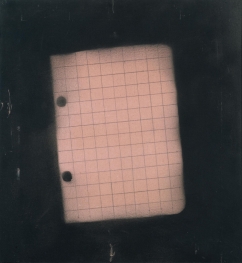He embarked on technical-scientific training, which he quickly abandoned
for an Engraving course. His first exhibitions appeared in 1964, leaving the
following year, with a grant from the Calouste Gulbenkian Foundation,
to London, where he attended St. Martin’s School of Art (1965-1966).
During this period, London received influences from Pop art but soon
moved towards its own language, marked by automatic gestures,
which seemed to be rehearsing a type of writing. It seeks, on the one hand,
a primordial formulation of communication through the use of graphic elements, scientific or symbolic signs, on the other, the saturation of the screen or paper by foreign signs or words, with no apparent relationship, points to the issues of illegibility and of incommunicability. In the 70s, in addition to the signs, which articulate letters and numbers, the surface on which they are inscribed was also of interest, using lined or checkered paper, canvases that imitate school slates, in an allusion to the genesis of writing, along with a committed light work. In the 90s, it was the clay/ground floors that marked his creative process, expressing an archaeological research into knowledge and language. His painting has been the subject of several retrospectives since the 90s, highlighting the exhibitions organized by the Center for Modern Art of the Calouste Gulbenkian Foundation (2002) and the Serralves Foundation (2003). In 2003 he was awarded the EDP Painting Prize and,
in 2011, he received the Amadeo de Souza-Cardoso Prize.
Leonor Oliveira










